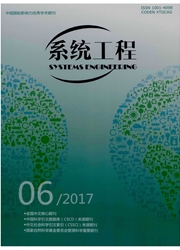

 中文摘要:
中文摘要:
“主制造商-供应商”模式越来越多地被飞机等复杂产品的研制生产采用,主制造商和供应商关系由竞争转为合作。基于供应商个体努力程度和合作程度构建了双重努力供应链协调模型,研究了主制造商非协调控制下纳什均衡和协调控制下的合作均衡问题,找出各情形下供应商的最优努力水平和合作程度,把非协调控制收益作为威慑点,建立了主制造商协调控制的利益分配规划模型.找出最优利益分配比例。研究结果表明.主制造商控制利益最优分配比例的同时可实现供应链整体利益最大化及供应商利益不受损的协调目的,并诱导供应商确定协调下的努力水平和合作程度,实现整个供应链的有效协调。
 英文摘要:
英文摘要:
At present, with the increasing use of the " main manufacturer-supplier" model in the development and manufacturing of complex products, such as aircraft and so on, the main manufacturer and supplier relationship transforms from competition to cooperation. The supply chain coordination model of double efforts is built based on the level of individual supplier's effort and cooperation, which addresses Nash equilibrium of main manufacturers under non-coordinated control and cooperative equilibrium under coordinated control. Furthermore, the distribution planning model of coordinated control of the main manufacturers is built based on the benefits of non-coordinated control, in which the benefit of non-coordinated control is considered as a deterrence point, to find the optimal level of the suppliers' effort and cooperation, and the optimal benefit allocation ratio. The results show that the main manufacturers can achieve maximum benefits of the whole supply chain and realize the co-ordination purposes of not damaging the interests of suppliers, while controlling the optimal benefit allocation ratio, and induce the suppliers to determine the level of efforts and degree of cooperation under the coordination, to achieve effective coordination of the entire supply chain.
 同期刊论文项目
同期刊论文项目
 同项目期刊论文
同项目期刊论文
 The Optimal Cost-Sharing Incentive Model of Main Manufacturer -Suppliers for Complex Equipment under
The Optimal Cost-Sharing Incentive Model of Main Manufacturer -Suppliers for Complex Equipment under Profits Distribution within Main Manufacturer and Suppliers in Supply Chain Based on Synergetic Theo
Profits Distribution within Main Manufacturer and Suppliers in Supply Chain Based on Synergetic Theo Development and Application of MSGT6.0 (Modeling System of Grey Theory 6.0) Based on Visual C# and X
Development and Application of MSGT6.0 (Modeling System of Grey Theory 6.0) Based on Visual C# and X A robust optimization approach to reduce the bullwhip effect of supply chains with vendor order plac
A robust optimization approach to reduce the bullwhip effect of supply chains with vendor order plac Methods of Face Recognition based on Local Singular Value Decomposition and Grey Relational Analysis
Methods of Face Recognition based on Local Singular Value Decomposition and Grey Relational Analysis An extension of grey target method with multistage fuzzy linguistic evaluation under incomplete weig
An extension of grey target method with multistage fuzzy linguistic evaluation under incomplete weig Research on irrational bubbles in the stock market based on the perspective of generalized virtual e
Research on irrational bubbles in the stock market based on the perspective of generalized virtual e Modeling and simulation of stranded passengers'; transferring decision-making on the basis of herd b
Modeling and simulation of stranded passengers'; transferring decision-making on the basis of herd b 期刊信息
期刊信息
